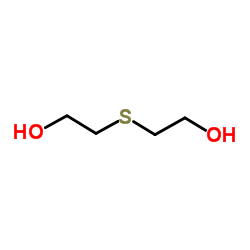thiodiglycol

thiodiglycol structure
|
Common Name | thiodiglycol | ||
|---|---|---|---|---|
| CAS Number | 111-48-8 | Molecular Weight | 122.186 | |
| Density | 1.2±0.1 g/cm3 | Boiling Point | 282.0±0.0 °C at 760 mmHg | |
| Molecular Formula | C4H10O2S | Melting Point | −16 °C(lit.) | |
| MSDS | Chinese USA | Flash Point | 139.5±19.1 °C | |
| Symbol |



GHS02, GHS06, GHS08 |
Signal Word | Danger | |
|
Quantitative structure-activity relationship and complex network approach to monoamine oxidase A and B inhibitors.
J. Med. Chem. 51 , 6740-51, (2008) The work provides a new model for the prediction of the MAO-A and -B inhibitor activity by the use of combined complex networks and QSAR methodologies. On the basis of the obtained model, we prepared and assayed 33 coumarin derivatives, and the theoretical pr... |
|
|
Redox Regulation of Cell Contacts by Tricellulin and Occludin: Redox-Sensitive Cysteine Sites in Tricellulin Regulate Both Tri- and Bicellular Junctions in Tissue Barriers as Shown in Hypoxia and Ischemia.
Antioxid. Redox Signal. 23 , 1035-49, (2015) Tight junctions (TJs) seal paracellular clefts in epithelia/endothelia and form tissue barriers for proper organ function. TJ-associated marvel proteins (TAMPs; tricellulin, occludin, marvelD3) are thought to be relevant to regulation. Under normal conditions... |
|
|
Developmental toxicity of thiodiglycol in Sprague-Dawley rats.
Int. J. Toxicol. 26(4) , 365-71, (2007) Thiodiglycol (TG), a hydrolysis product of sulfur mustard (HD), is a potential contaminant of soil and water at certain military sites. To establish developmental toxicity criteria for TG, an oral developmental toxicity study was conducted in Sprague-Dawley r... |
|
|
Quantitation of the sulfur mustard metabolites 1,1'-sulfonylbis[2-(methylthio)ethane] and thiodiglycol in urine using isotope-dilution Gas chromatography-tandem mass spectrometry.
J. Anal. Toxicol. 28(5) , 327-32, (2004) Sulfur mustard (HD), or bis(2-chloroethyl)sulfide, has several urinary metabolites that can be measured to assess human exposure. These metabolites include the simple hydrolysis product thiodiglycol (TDG) and its oxidative analogue, TDG-sulfoxide, as well as ... |
|
|
Determination of thiodiglycol, a mustard gas hydrolysis product by gas chromatography-mass spectrometry after tert-butyldimethylsilylation.
J. Chromatogr. A. 1061(2) , 235-41, (2004) A method for determining thiodiglycol (TDG), a mustard gas hydrolysis product in water, serum and urine samples using gas chromatography-mass spectrometry (GC-MS) after tert-butyldimethylsilylation (TBDMS) is described. Quantitation of TDG was performed by me... |
|
|
The effect of mustard gas on the biological activity of soil.
Environ. Res. 106(3) , 289-95, (2008) A special group of substances that are very dangerous for the biosphere includes war gases such as mustard gas (bis(2-chloroethyl)sulphide). The influence of mustard gas hydrolysis products (MGHPs) on soil microbiota has been investigated. These substances be... |
|
|
Monitoring sulfur mustard exposure by gas chromatography-mass spectrometry analysis of thiodiglycol cleaved from blood proteins.
J. Anal. Toxicol. 28(5) , 306-10, (2004) A gas chromatography-mass spectrometry method for determining exposure to the chemical warfare agent 2,2'-dichlorodiethyl sulfide (sulfur mustard; HD) has been developed. The technique is based upon quantitating thiodiglycol (TDG) released from blood protein ... |
|
|
Screening hydrolysis products of sulfur mustard agents by high-performance liquid chromatography with inductively coupled plasma mass spectrometry detection.
Anal. Bioanal. Chem 393(8) , 1949-56, (2009) Sulfur mustard (HD), bis(2-chloroethyl)sulfide, is one of a class of mustard agents which are chemical warfare agents. The main chemical warfare hydrolysis degradation products of sulfur mustards are: thiodiglycol, bis(2-hydroxyethylthio)methane, 1,2-bis(2-hy... |
|
|
Biodegradation of thiodiglycol, a hydrolyzate of the chemical weapon Yperite, by benzothiophene-desulfurizing bacteria.
J. Hazard. Mater. 167 , 124-127, (2009) Microbial degradation of thiodiglycol (bis(2-hydroxyethyl)sulfide, TDG) with petroleum-desulfurizing soil bacteria was examined. Among the bacteria tested, several strains belonging to the genera Rhodococcus and Gordonia grew on TDG as the sole sulfur source.... |
|
|
Analysis of the sulphur mustard metabolites thiodiglycol and thiodiglycol sulphoxide in urine using isotope-dilution gas chromatography-ion trap tandem mass spectrometry.
J. Chromatogr. B. Analyt. Technol. Biomed. Life Sci. 845(1) , 114-20, (2007) A sensitive method has been developed for the trace analysis of the sulphur mustard metabolite thiodiglycol (TDG) in urine, and its oxidation product thiodiglycol sulphoxide (TDGO) after reduction to thiodiglycol. Thiodiglycol was extracted from urine by soli... |